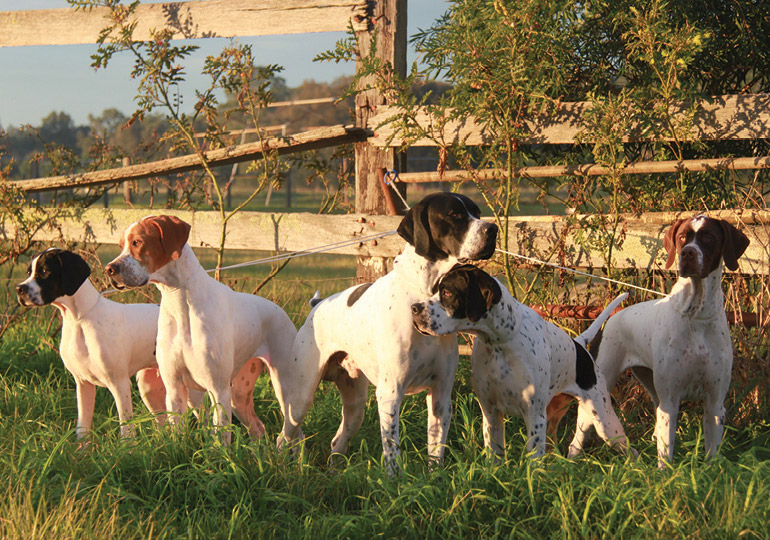Pointer
Breed Details
Size:
Exercise Requirements:
Grooming Requirements:
20-34 Kg (Approx)
12-17 years

Appearance
The Pointer’s freeze on classic point is unmistakeable, with nose and head held high, tail straight, taut and carried level with the top line, and showing every muscle of its well-built body. They are a symmetrical series of graceful curves and lines, having a strong but lissom appearance. Bred to gallop, they need strength, endurance and speed.
The head is the feature of the breed. Pointers should have a well defined stop and from this point forward the muzzle should be somewhat concave, giving a slightly ‘dish-faced’ appearance. The stop alone is not what creates the Pointer’s ‘dish face’; it is also enhanced by the carriage of the head. When on the move and especially when working in the field, the head and arched neck are carried high, as the Pointer’s role is not to follow foot or ground scent but to detect game scent in the air.
The ‘dish face’ with a large, moist, open nose, provides better scenting ability, and allows the dog to gallop without holding its head overly high. A dog with a level or downward-sloping muzzle has to hold its head in an unnaturally high position. This puts strain on the neck and can restrict the windpipe, reducing air intake. This in turn affects endurance and stamina.
Tail : The tail is medium length, thick at the root and tapers to a point. On the move it is carried straight and level with the top line, lashing from side to side with each stride. There should never be any upward curl or high carriage of the tail. The foundation breeders described the tail as a ‘bee sting’, and considered a tail with a high carriage a very undesirable Hound trait.
Gait: Being a working Gundog and expected to run all day, the Pointer must have a smooth, frictionless gait, covering plenty of ground – definitely not a hackney gait. It should have long reach in front, hocks that reach under the dog to drive it forward and a driving hind action.
Coat: Pointers have a short coat with a decided sheen, which makes them low maintenance. Colours are black, orange, liver and lemon, either solid or in any combination with white. Tricolours are also acceptable. There is no such thing as a badly coloured or marked Pointer.
History
Though the origin of the Pointer lies in Europe, the English created the breed as we see it today, from the Spanish Pointers imported with returning British troops after the Spanish War of Succession in 1713. Pointing and Braque type dogs can be seen in paintings from Italy and France from the 1500s, but few of these dogs would have been imported to England.
The Spanish Pointer was a heavier type of dog. A slow, methodical and very accurate worker, its lack of speed complemented the style of hunting at the time, with the use of flintlock guns and nets. As technology evolved and the pace of hunting increased, a faster dog with more stamina and endurance was needed.
Some breeders decided to outcross using Foxhounds, Greyhounds, Bloodhounds and Terriers. These outcrosses were not accepted by all breeders, as some feared that the changes would reduce the ‘pointing’ instinct. Dog shows saved this breed. The first recorded dog show was held in 1859 at Newcastle-upon-Tyne. It was restricted to Pointers and Setters, and its aim was to settle the argument as to which of the working Gundogs was better looking.
As dog shows became more frequent, the Pointer breeders decided to stop the tendency to change the breed’s appearance with the outcrossing to Hounds and Terriers. They set a ‘type’ using the existing lines and strains, and it is still very undesirable today for a Pointer to show Hound or Terrier traits. As a result, the general characteristics of Pointers today have changed very little from their forebears. They are powerful, energetic hunting dogs of medium size.
Temperament
Pointers’ kind, even disposition makes them excellent for field work, showing or a family pet. Gentle and fun loving, they enjoy human interaction and are very loyal and affectionate.
Their willingness to please makes them a good choice for Obedience, Agility and Jumping, or as a jogging companion. As they are highly energetic and enthusiastic hunters, they require an owner who can provide lots of exercise.
The aristocrat of the Gundogs, the Pointer is a professional worker, an elegant, eye-catching show dog and an ideal companion for an active family. The only problem with Pointers is that once you own one, it’s very hard not to have two or three.
Care/Grooming
The Pointer's short, dense, glossy coat requires minimal maintenance. A weekly brushing with a soft-bristle brush or a hound glove will help to remove dirt and loose hair and keep the dog looking his best. The ears should be regularly inspected and cleaned if needed with soft gauze and an ear-cleaning solution your veterinarian can recommend a good brand to use. The nails should be trimmed often if not worn down naturally, as overly long nails can cause the dog discomfort and problems walking and running.
Pointers are generally very healthy dogs, and responsible breeders will screen their stock for health conditions such as hip dysplasia and eye disorders. Like other large and deep-chested dogs, Pointers can experience bloat, a sudden, life-threatening stomach condition. Owners should learn what signs to look out for, and what to do should they occur. The Pointer's ears should be checked regularly for signs of infection, and the teeth should be brushed often, using a toothpaste designed for dogs.
Breeders
Currently no Breeders in SA for this Breed

